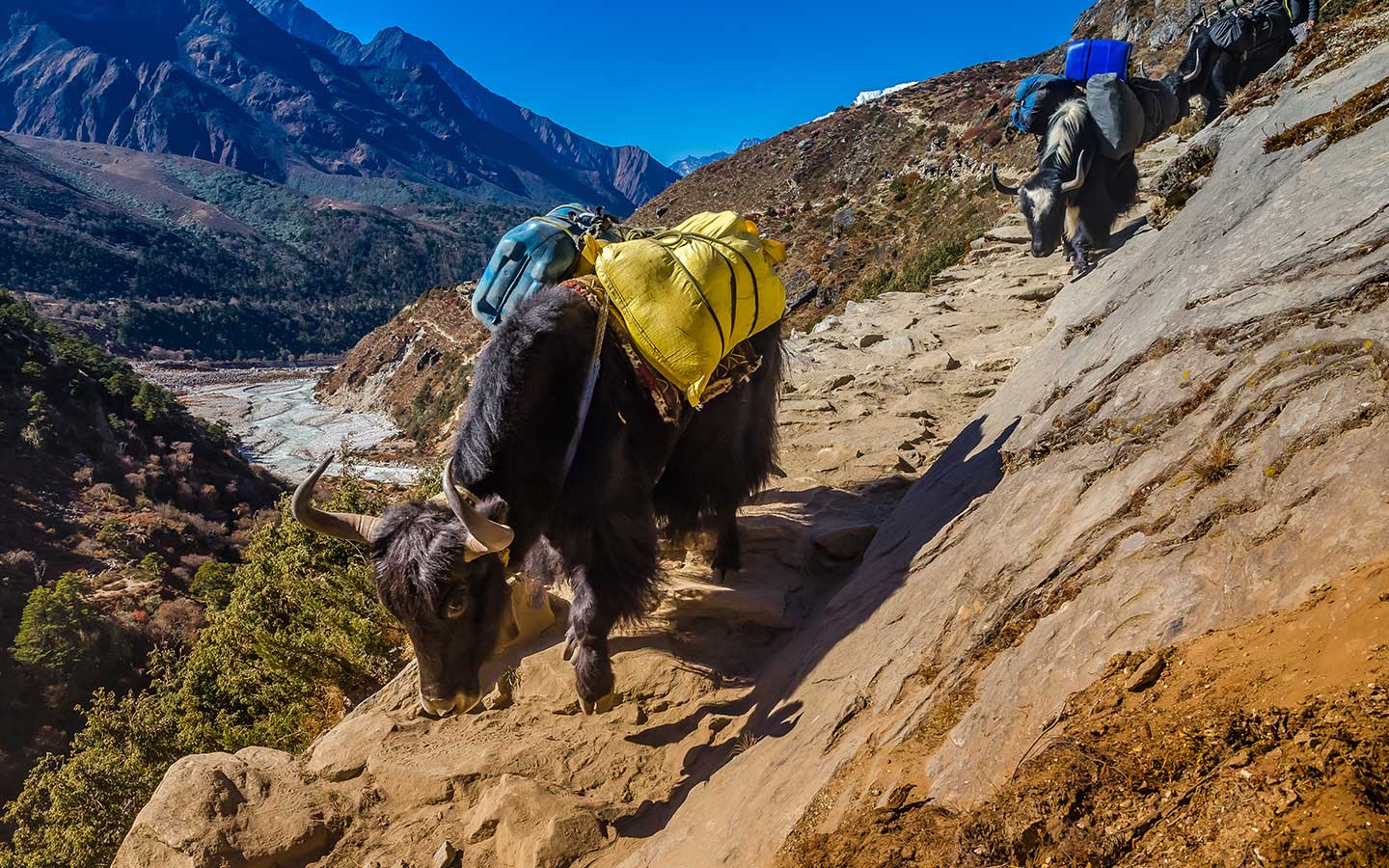What Animals Live On Mount Everest?


Mt. Everest (8848 meters) lies in the famous Mahalangur Himalayan range of Nepal. The summit of the mountain experiences one of the most freezing temperatures in the world. Besides that, the climate of the Everest region is not favorable for green vegetation, and the wildlife is few and rare.
Of course, the mountain peak remains uninhabitable, and there is no wildlife. However, the Sagarmatha National Park of the Everest region is a hub of many rare and endangered wildlife species. The pristine National Park in the Himalayan region is responsible for the protection and the conservation of the natural wildlife of the region.
So, what animals live on Mount Everest Region? You will be answered for your query down below in this article.
List of Animals on the Mount Everest region
Himalayan Tahrs
Himalayan tahrs are wild mountain goats native to the Himalayas region. It is densely found in the Everest region of eastern Nepal. It is also on the IUCN Red List, owing to hunting and habitat loss. The males Himalayan Tahrs headbutt each other as a part of a mating ritual in the breeding season.
The Himalayan tahr has a small head, large eyes, small pointed ears, and horns. Female Himalayan tahrs are relatively lighter in weight, size and have smaller horns. They have thick exterior, reddish wool coats as they protect them from harsh winters. The Himalayan tahr has a lifespan of around 14 or 15 years. They are herbivores and graze on grass, leaves, and fruits. They are primarily found in between Phortse and Pangboche.
Red Panda
The red panda is another endangered animal found in the Everest region. Moreover, It is on the List of Endangered on the IUCN Red List because its population continues to decline. They are pretty close to the level of extinction due to poaching as their fur has significant value in the black market.
A reddish-brown fur and a long hairy tail are a highlight in a red panda. It has its main diet on bamboo but also feeds on birds and insects. It is shy, solitary, and territorial. Travelers can find them from dusk to dawn, as they remain primarily passive in the daytime. They are mainly found in Jorsale in the Everest region.
Snow Leopard
The snow leopard is a beautiful animal native to the Himalayas. It is also listed in the IUCN Red List as a “vulnerable” species since there are fewer than 10,000 mature individual snow leopards. Moreover, their population is also expected to decrease by 10% by 2040. Poaching and habitat destruction are two of the primary reasons for its decline.
It is generally found in the alpine regions with elevations that range from 3,000 to 4,500 m. The Himalayas range from Afghanistan to the Tibetan Plateau and Nepal. The snow leopard has small rounded ears that help minimize heat loss. Its broad paws allow it to walk on snow by distributing weight.
Moreover, having fur on its back increases the grip on steep and unstable surfaces. The long and flexible tail is thick due to fat storage and maintains balance in rocky terrain.
In the summer seasons, this snow leopard lies above the tree line on alpine meadows. Snow leopards are territorial and use scent marks and scrape the ground to indicate their territories. The snow leopard is generally found in the Gokyo lake area of the Everest region.
Musk Deer
Musk deer look similar to small deer but belong to a different family. They are different as they lack antlers and facial glands and have a particular musk gland. Their habitat is alpine scrub and forests in the Himalayas foothills.
The musk gland in adult males is located between the genitals and the umbilicus. They produce secretions that attract mates during the breeding season. These herbivores live in hills and gorge on grasses, leaves, forests, mosses, and lichens. They mark their territory with their scent. Musk deer are nocturnal and remain active between dusk and dawn.
Male musk deer also compete with their tusks in mating season. The female musk deer produces fawns after around 150-180 days. Their scent glands are widely known to be aphrodisiac and thence are used in perfumes. They are even sold in the black market for around $45,000/kg. They are found in Deboche, Tengboche, and Phortse in the Everest region.
Wild Yak
The wild yak is among the largest bovid species and is the ancestor of domestic cattle. The females are 30% smaller when compared to wild bull yaks. These heavily built animals have bulky frames, rounded cloven hooves, sturdy legs, and others. They have a wooly undercoat with shaggy hair that provides insulation against the cold.
The wild yak is also found from southern Siberia east of Lake Baikal to Bhutan. Moreover, the primary habitat includes an alpine region with an altitude of 3,000 and 5,500 m. They are also found in alpine tundra with thick grasses. The wild yak diet includes grasses, herbs, shrubs, mosses, and lichen.
Furthermore, the Himalayan wolf and snow leopard is a natural predator of Yak. Wild yaks move in a herd of primary females and a few adult males. Wild yaks generally avoid humans and can get aggressive or flee when approached. They are found from Namche to Tengboche in the Everest region.
Himalayan Pika
The Himalayan Pika is a small mammal found at the high altitudes of the Himalayas in Nepal. This mammal remains listed as “least concern” by IUCN. The Himalayan pika lies in the Mount Everest region, with altitudes ranging from 2,400 to 4,200 meters.
The rocky region, screes, and cliffs of coniferous forests are their natural habitat. They feed on grass, leaves, and plants and are generally found in remote areas away from human settlements. The IUCN has also advocated more conservation of this small mammal in the Everest region.
Black bear
The Himalayan black bear is generally found in India, Bhutan, Nepal, China, and Pakistan. Moreover, they are a subspecies of Asian black bears. The black bears are typically found in warmer areas within an altitude range of around 3,000 to 3,700 m.
They feed on acorns, fruit, nuts, roots, and honey and are omnivorous. They also gorge on insects like termites, beetles, and larvae. They can also eat livestock like goats, sheep, and cattle if food is not readily available in the region. They are listed as ‘vulnerable’ by IUCN due to forest fires, human encroachment, etc.
Mountain weasel
The mountain weasel is generally found in high-altitude environments, including tundra and grassy woodlands. The rock crevices abandoned burrows, and tree trunks are where these small animals rest. The species are generally found in high-altitude regions from Kazakhstan to the Everest region in Nepal.
The IUCN has listed it as near threatened as there is a significant decline in its population that requires proper conservation. The males are large and undergo seasonal molts as well. These solitary nocturnal animals only come together while mating and are polygynous.
They are capable of climbing, swimming, and running. Their short legs and long bodies make them quite agile. They communicate visually and vocally as they have excellent vision. They can produce sound to warn of possible predators when mating and charter territories.
Yellow-throated marten
The yellow-throated marten is a native to Asia. The IUCN has listed it as “Least Concern” on the Red List. It is due to its relatively stable population, wide distribution, and lack of other threats.
The yellow-throated marten is large with bright fur with white, black, golden-yellow, and brown. It is an omnivore and diets on fruit and nectar, and even on small deer. The yellow-throated marten has a robust build, bright coloration, and unpleasant odor. They are generally found in areas below Namche.
List of Birds on the Mount Everest region
Tibetan snowcocks
The Tibetan snowcock is a pheasant family bird. They are found in high-altitude regions of the foothills of the Himalayas and the Tibetan Plateau. They have greyish hair and a white crescent patch behind the eye.
The broad white trailing edge forms a wing band in this bird. Females have the postocular patch, blackish and buff marks, and lack the tarsal. The IUCN listed Tibetan snowcock as “least concern” as they have large distributions and no significant decline.
Himalayan monal
The Himalayan monal is a pheasant native to the forests of the Himalayas. It is listed as a “Least Concern” on the IUCN Red List. The bird is known as danphe in Nepal, where it is also a national bird. This relatively large-sized pheasant is about 70 cm (28 in) long.
The Himalayan monal is native to the Himalayas foothills that range from Afghanistan to Sikkim. It is also located on grassy slopes, alpine meadows, cliffs between 2700 and 3700 meters in altitude. It can descend to 2,000 m (6,600 ft) in the winter. It can dig up snow to feed on plant roots and insects.
Blood peasant
The Blood Pheasant is a relatively small, short-tailed pheasant native to the eastern Himalayas. The species has been listed as “least concern” by IUCN as its population is in gradual decline.
They are under significant threat due to various reasons, including habitat loss, illegal harvest, fragmentation, and human disturbance. The bird has ground-nesting habits and a long incubation period. This factor makes them vulnerable to habitat degradation and trampling.
Hence, these were the significant animals and birds in Mount Everest region. Besides that, there are many other species of wildlife in the beautiful foothills of Everest.
How do animals survive the cold?
The harsh winter of the Everest Region makes it difficult for the animal to survive. The thick fur animals can only survive the cold climate of the Everest region. And the wide feet help them to walk on the snowy rock. Hence, their biological diversity allows them to adapt and survive in a high altitude environment. Overall, the diverse Everest Region provides you a limited but exciting range of wildlife animals along with majestic mountain views.
What kind of birds get found in the Everest region?
Well, there is a limited variety of birds in the region. We can spot the endangered species of beautiful Ruppell’s Griffon Vulture and the Bar Headed Goose flying over 37000 feet in the Everest region. Bar Headed Goose is also the highest flying bird in the world.
Everest Region and its wildlife
Some of the wild animals of the Everest region include Snow Leopard, Himalayan Tahrs, Red Panda, Musk Deer, and Wild Yak. Snow Leopard and the Red Panda are among the rare and endangered species of the country. There are only about 500 Snow Leopards remaining in the Himalayas of Nepal.
You might encounter some of these animals during the trek of Everest Base Camp. But the sightings are quite rare. You can find them active, especially in the Spring and Autumn season. These animals are only active in the lower altitudes of less than 5750 meters in the Everest region.
Moreover, Tibetan Gazelle, Blue-sheep, Pika, and Wild yak are even found at the altitude of 6100 meters. Besides that, the Himalayan Jumping Spider is also spotted at the height of an altitude of 6700 meters. Their bodies measure around 1 to 25 mm. They hide in crevices and feed on frozen insects blown by the wind.
Furthermore, the lower region has many trees of Rhododendron, Oak, and Pine. Himalayan Wolf, Himalayan Gorals, Himalayan Black Bear are also found in the Everest region. There are, however, no reptiles in the area.
You may also like:



